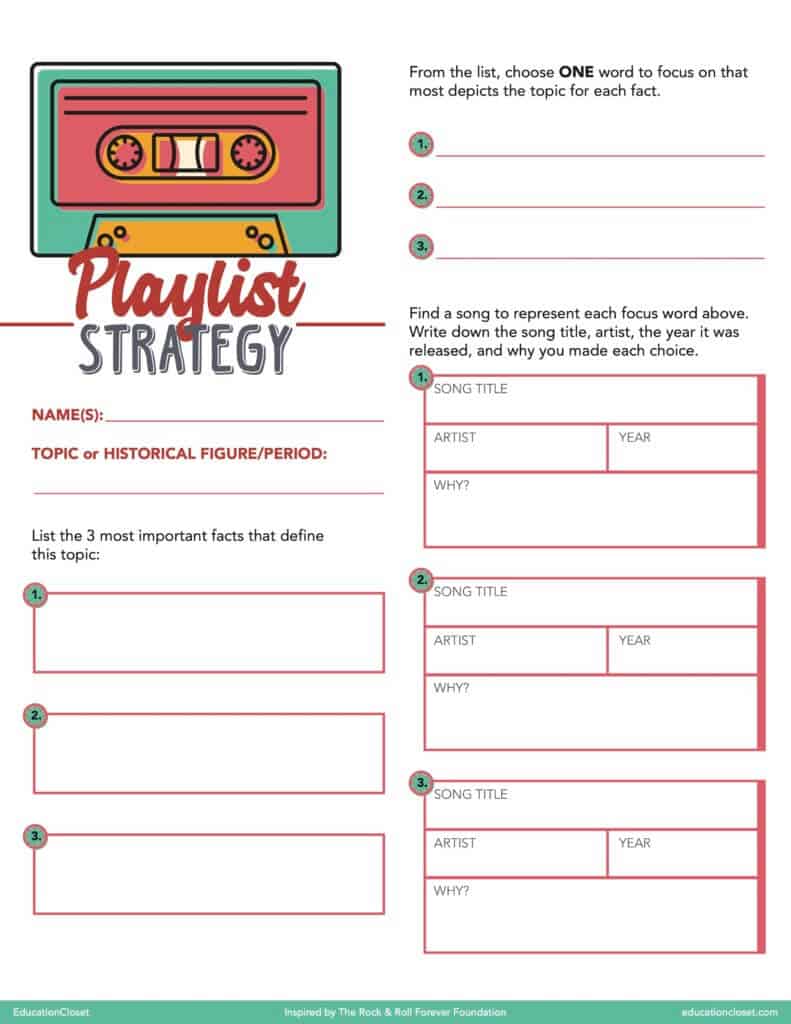Classroom Playlists: Bringing Learning to Life
4 Min Read • Music
One of the most visible benefits of arts integration is the increase in student engagement. Everyone wants their students to connect to their content area. What better way than through the use of Popular Music?
We live in a connected world and I can’t walk the halls of my school without passing a student wearing earbuds or headphones. Our students connect to music every day in their personal lives. If you can integrate their connection to music with your content, it is a win-win all around!
There are numerous strategies available, for every art form, to act as a kick-starter or opening activity to an arts integration lesson. These strategies can also serve as a stand-alone activity or as an evaluation tool. Arts integration strategies provide students with a hands-on, brains-on, experience that can translate across multiple disciplines.
I came across a great strategy from The Rock and Roll Forever Foundation that can integrate music with ANY content area.
Classroom Playlists Strategy:
DETERMINE THE TOPIC
Determine your topic, person/historical figure, or historical period. It can be anything from any content area!
WHAT IS YOUR INTENT
You can either pre-teach information about that topic or historical figure OR have the students complete research to create a list of facts about the topic or person. How you use it will depend on your intent – before teaching, during a lesson, or after a lesson. This strategy can also flip your classroom, making your students the teachers of the content!
SELECT 3 FACTS
I suggest that you have the students work in pairs and select 3 facts about that topic/person. Each fact should be broken down to just one word that REALLY describes the topic/person.
SONG SEARCH
Have the students use Google or YouTube (or iTunes, etc) to search for a song containing that fact – just the one word – in the lyrics, song title, or artist’s name. With older students, you can also have them write down the artist’s name and you may even want them to give you the year the song debuted for historical/cultural context. Last, have the students write down HOW that song/artist depicts, or represents, their topic/person.
PLAYLIST CREATED
Once they have done this for all 3 facts, they will then have their “Playlist.”
PRESENTATION
Each pair should present their Playlist (song title, artist, year)…either on a written sheet, slide deck presentation, or verbally to the class. Extension – If you have the students use a slide deck presentation, they can include links to YouTube videos of the 3 songs.
ASSESSING LEARNING
In the past, I have had students (in pairs) try to guess the topic/historical figure for each playlist and write it down on a sheet that they turn into me at the end of the “presentations” OR you could just have them guess out loud as a class – just depends on your intent for the activity. Does it serve as a diagnostic, formative or summative assessment? And, how much weight do you want to give it? You can also have the pairs turn their completed playlist in to you for a grade, in addition to their guesses of the other groups’ topics/people.
For Example…
Here’s a sample of one way that I have used this strategy with a social studies class:
George Washington (topic/historical figure)
- B52s – “Wig” (he wore a wig)
- Fiona Apple – “Every Single Night” (name Apple)
- Martina McBride – “Independence Day” (song title)
Try it out!
Below you will find a resource for this assignment that can also serve as a guide your students. My students LOVE using this strategy and I hope yours do too! One of the E/LA teachers that I work with turned it into a game… “Whose Playlist Is It Anyway?” based on the characters in a novel they were reading. Everyone had a blast and she said that it was the most engaged she’s ever seen her kids!
In addition to using this strategy for music, it can easily be adapted for all art forms as follows:
- Visual Art – find pieces of artwork to represent each fact
- Theater – find monologues, scenes, plays or musicals to represent each fact
- Dance – find dances to represent each fact
- Media Arts – find images to represent each fact
Or, you can use mixed art forms giving the students even more choice in the expression of their learning!




